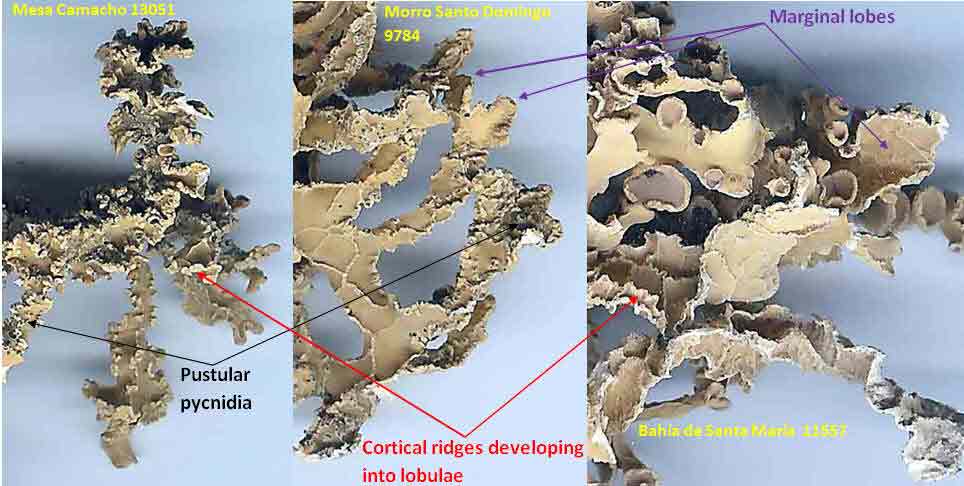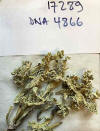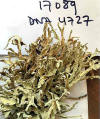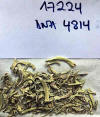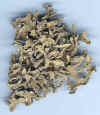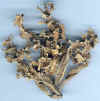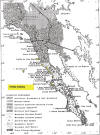|
Niebla lobulata
is a species of fruticose lichen endemic to Baja California, occurring on Is. Guadalupe, Is. San Martín, and
on the main peninsula from the Vizcaíno Peninsula north to Punta Canoas.
It usually grows on red volcanic rocks at the fringe of the fog zone.
The species is generally characterized by having sekikaic acid (and
triterpenes) and broad ribbon-like branches, sometimes tubular near base,
contorted and undulate, occasionally with sharply pointed segments,
usually with round lobes, and reticulately ridged cortex in the upper half of
the thallus.
Niebla lobulata is
often similar to other species with which it occurs such as N. caespitosa (divaricatic acid),
N. dilatata
(divaricatic acid), N. flabellata (salazinic acid),
N. marinii
(salazinic acid), N. podetiaforma (divaricatic acid),
N. rugosa
(divaricatic acid), and N. sorocarpia (divaricatic acid). Its
variable cortical features and lobed margins are much like the variable marginal
features recognized for
Niebla laminaria, which is distinguished by its chemistry of divaricatic acid and
rigid thallus. Determination of the secondary metabolite, sekikaic acid, is often necessary for
positive identification of N. lobulata, while it also appears to
intergrade with other sekikaic-acid species such as
N. suffnessii and
N. siphonoloba.
The former is distinguished by long sublinear branches, and the latter differs
by the subtubular branches lacking secondary or fragmentation branchlets Thalli on the
Vizcaíno Peninsula were found to have larger spores and additional triterpenes.
Internet Images of Niebla thalli reportedly taken in the Santa Monica Mountains
by Jason Hollinger (2011-10-19), which were identified
N. homalea, appear to be
N. lobulata. The Baja California thalli have a relatively thin cortex over a subfistulose medulla,
whereas the California thalli may be recognized to have firmer branches as a
result of a thicker cortex. Further study may include specimens from Morro Bay
and Channel Islands.
DNA phylogeny (Spjut et
al. 2020) indicates
the species to be polyphyletic in which four species for six specimens collected
were delimited under that name by BPP and Stacey analyses, and two in Jorna et
al. (2021) for two specimens collected at different locations (Puerto Catarina,
San Quintín) for BPP; however, the species is supported with a narrower
geographic range when the
phylogeny takes into consideration collections from the type locality. As noted
in the caption for the above phylogeny image, this includes four specimens
collected by Leavitt et al., and two cited in Spjut et al. (2020, Fig. 7, 4861,
4866) from the type locality in the NVD (Morro Santo Domingo) but none of the
topotypes were chosen for analyses by Jorna
et al. (2021). One additional specimen cited by
Spjut et al. from
Bahía Tortugas (BT), 17219-4812, in the SVD
occurs in a sister clade to those from the type locality. Leavitt et
al. 16-901 unresolved (N. lobulata
X N. siphonoloba) is more closely
related to specimens in the Desert Chaparral Transition than to topotypes
16-899, 16-906, 16-908, 16909. Leavitt et al. 16-906 is most similar
morphologically to the type specimen, and would appear to be good a choice for an
epitype.
Additional References: See
Niebla
|
